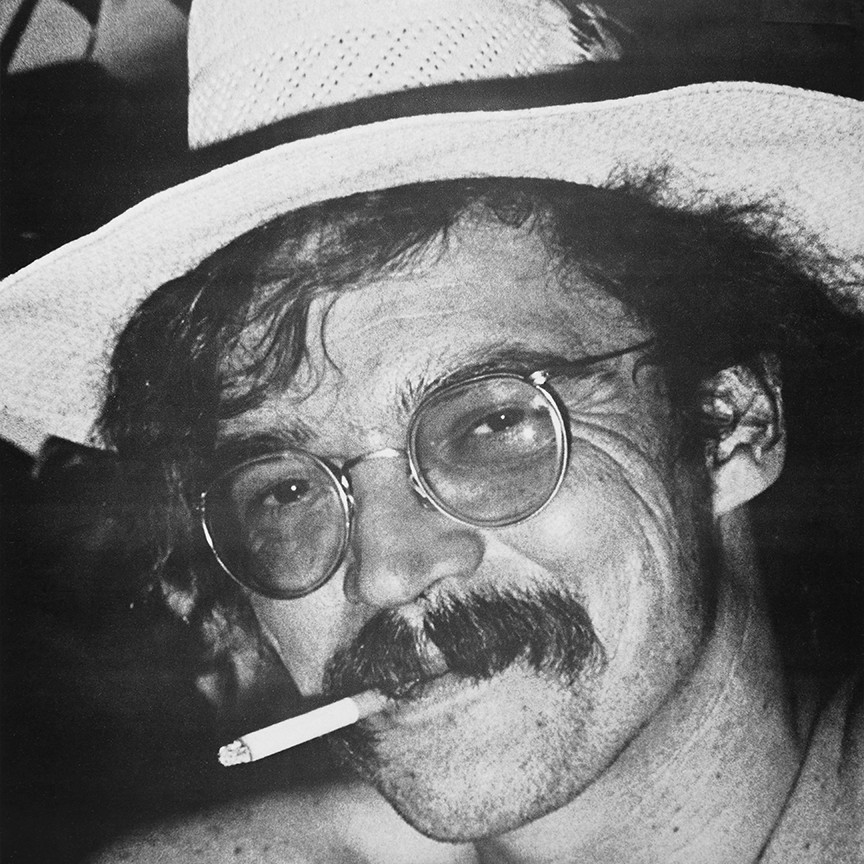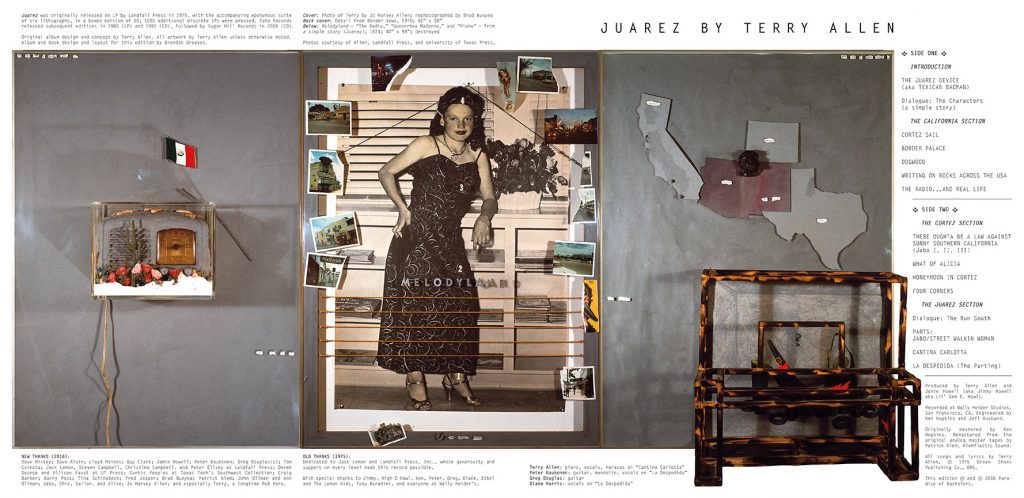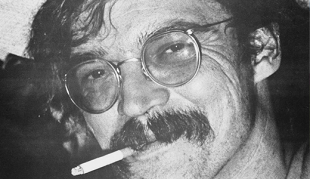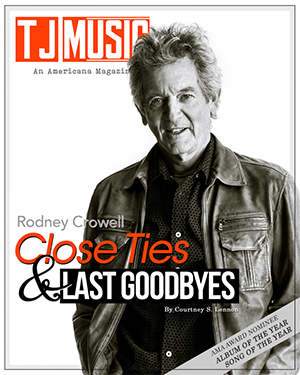By Terry Roland
Imagine a stormy West Texas night. A freak storm has just hit in the middle of August. Monsoon winds blow through from Mexico. We are in a near empty room with fading paint-chipped walls and a single antique player piano that has long since lost its honky-tonk styled solo playing capacity. The only place to sit is on the floor against the old walls of this abandoned house. There at the piano is a poet, a songster, a sculptor, a painter and a storyteller. He begins to play and sing to the natural reverb of the ancient walls. It’s just the four of us in an empty room, a broke down honky-tonk player piano, my weary-windblown-self, and this storyteller-poet. With a lonesome Texas-Leon-Russell drawl, he sings about a ‘Texican badman’ who crosses the border into Juarez ready for a misguided adventure.
Our narrator and host on this lonely noir-tale? Terry Allen. It could be no one else. A veteran West Texas poet and storyteller at his finest.
The opening song “Juarez Device (Texican Badman)” is the prologue that foreshadows a menacing tale of romance and murder. A narrative ensues. Juarez. Enter the characters, Sailor- a young man on leave in San Diego, Spanish Alice a Tijuana barmaid, Jabo, a Juarez native on a Los Angeles joy ride and Chick Bundy-Jabos’ prostitute girlfriend.
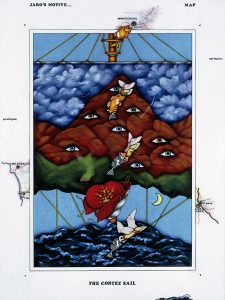 As Terry Allen speaks and sings to the foot pounding rhythm of a Southwest night, the night turns black & white with a touch of evil that pulls us under. The two couples are on their way to an accidental meeting in Cortez, Colorado. Jabo murders Spanish Alice and Sailor as Chick watches. The two go on the lam. They head for the border town of Juarez, by way of Los Angeles with a massive manhunt in their wake.
As Terry Allen speaks and sings to the foot pounding rhythm of a Southwest night, the night turns black & white with a touch of evil that pulls us under. The two couples are on their way to an accidental meeting in Cortez, Colorado. Jabo murders Spanish Alice and Sailor as Chick watches. The two go on the lam. They head for the border town of Juarez, by way of Los Angeles with a massive manhunt in their wake.
The song-cycle continues. “Cortez Sail” a rainy-night home ballad from Jabo’s memories of ‘goin’ home—’heading north to go south.’ The tale then drifts into a waltz-time dream of the Spanish conquerors, four-hundred years before, when Cortez arrives with men, guns and a ‘Spanish-Christ alive on his lip.’ Fade to black as mass genocide begins.
“Border Palace” cuts to Sailor’s leave in a Tijuana bar hitting on Spanish Alice to the raging blues of a slide guitar. Cut back to Jaba’s persuasive “Dogwood” tale of woe which successfully convinces Chick to come with him to Juarez, by way of Cortez, Colorado. “Writing on the Rocks Across the U.S.A” finds Jabo illegally making his L.A. graffiti mark on the American landscape through a windy, stormy night, on his way to Cortez to the sound of thunder. “The Radio, Real Life” is a driving tune that segues between the serenity of a radio love song and the real life of Sailor’s lusty and erotic first night with Spanish Alice. Somewhere, between the lines they are married. “There Oughta Be a Law Against Southern California (Jabo 1,11, 111) fast forwards to the aftermath of the slaughter of Alice and Sailor in Colorado. Jabo and Chick leave a trail of robbery and murder as they move toward East L.A. He sings, “I leave a few people dead but I got open road up ahead.” And Juarez is always on his mind.
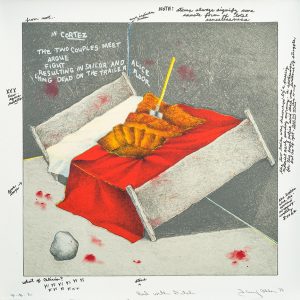 “What of Alicia” is an ode to the murdered Tijuana waitress, Alice, and her lover, Sailor. A gentle memory of innocence lost and true love found then, in the flash of haunted storm-ridden night, gone. The wind blows through the ancient room as the Storyteller’s piano and a mandolin fade and bring us to a flashback to the Colorado trailer where Alice and Sailor bask in married bliss on “Honeymoon in Cortez.” The next chapter, “Four Corners,” comes from Sailor with memories his Mexican bride and Colorado. It’s a tricky narrative Allen plays on us going back then forward, going in all directions, across border after border.
“What of Alicia” is an ode to the murdered Tijuana waitress, Alice, and her lover, Sailor. A gentle memory of innocence lost and true love found then, in the flash of haunted storm-ridden night, gone. The wind blows through the ancient room as the Storyteller’s piano and a mandolin fade and bring us to a flashback to the Colorado trailer where Alice and Sailor bask in married bliss on “Honeymoon in Cortez.” The next chapter, “Four Corners,” comes from Sailor with memories his Mexican bride and Colorado. It’s a tricky narrative Allen plays on us going back then forward, going in all directions, across border after border.
Then, Allen as narrator breaks into the story as a newscaster who reports the discovery of the murdered bodies of Sailor and Alice. Meanwhile Jabo and Chick are setting the interstate on fire with automobile speed and dead bodies. Shades of Terrence Malick’s Badlands. There is a shoot-out with the police and then they escape to the desert where they make crazy love. They grow disillusioned with each other in El Paso as the magic drains away. The next day on a border bridge from El Paso to Juarez, they part. Chick changes her name to Carlotta and returns to her old occupation as is told in “Street Walking Woman.” Then, there is a story diversion. The direction turns sideways on “Cantina Carlita” from the perspective of a business man who leaves his life behind to spend a night with Carlota.
The final chapter finds Jabo near the border in the Juarez mountains longing for East L.A. then then drifts into, “La Despedida (The Parting),” a post-script ballad portrait of an aging Mexican torch singer.
Slowly, the storm clears as dawn is on the West Texas horizon. We wake to a wink and a smile from Terry Allen, our journeyman host who has taken us through a barren landscape of characters bent on desperation, romance, lust, murder and restless despair. There is no resolution here. No redemption except the one found in the ‘Texican Skies’ and the El Paso plains. It is a straight forward tale of the border crossing of four lost souls into each other’s lives, as they make their way past state, international and mortal borders. They finally cross a final border between light and darkness. Darkness is all that remains for these characters carefully drawn by Terry Allen, as the Lubbock sunrise begins to crawl from the old broken window into the faded wood floors of the room. The End of our story. Juarez by Terry Allen.
The album is a now-under-recognized classic first released 1975. Since Terry Allen is primarily a visual and multi-media artist, the album was intended to be a part of an art exhibit. It is a country-opera, a concept album without borders in style or content. If Townes Van Zandt had found the focus and a touch of sobriety, he may have accomplished a work like Juarez. Ironically, Townes has become an icon in the Americana-roots music world, while Terry Allen remains largely unknown (for his music) outside of the Southwest. However, as a visual artist, he has been internationally exhibited. He is also a noted academic with advanced degrees. But, spending a little time inside inner room of this cycle of songs is to understand there is no difference between the stroke of his brush, or the strike of his pen. It all springs from the same creative well.
Juarez truly stands the test of time. It was born a full decade before the term, “Americana” was coined. He was Americana before Americana was cool (with apologies to Barbara Mandrell). His 1975 debut is a classic example of a songwriter taking risks as he breaks the mold on country concept albums. He turns a tale of murder into a universal story of human transformation. Juarez was released the same year as Willie Nelson’s similar opus, Red Headed Stranger. The two albums are remarkable in the way they circle and parallel each other without influence from either.
Juarez, which came of age as Cormac McCarthy’s career was still in its embryonic stage, works as a basis for a novel or a screenplay. It is like reading McCarthy. It carries the same minimalist yearnings of McCarthy.
Finally, Allen takes us off into the edge of a desperate night. If you close your eyes and sit back in a dark room, the characters and nourish storyline comes to eerie life. It’s a ride that shouldn’t be missed if you truly love great art and the magic of the story all wrapped up in a stripped down one-take-live-in-the-studio recording. In the end, Juarez is a road-trip of the mind well-worth taking.
Terry Roland
Latest posts by Terry Roland (see all)
- John Prine: An Appreciation - April 21, 2020
- Kinky Friedman: Deep in the Heart of Texas - June 18, 2018
- Chris Hillman’s Still Flying High on New Album, Bidin’ My Time - December 8, 2017

